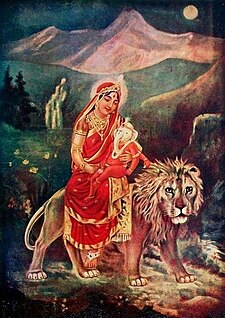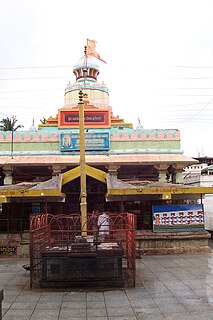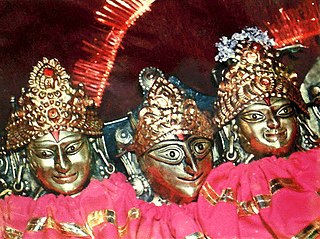
Parvati, Uma or Gauri is the Hindu goddess of power, nourishment, harmony, devotion, and motherhood. She is Devi in her complete form. She is the principal goddess of Hindus and complete incarnation of Mahadevi. She is one of the central deities of the Goddess-oriented sect called Shaktism. Along with Lakshmi and Saraswati, she forms the Tridevi.

Durga is a major deity in Hinduism. She is worshipped as a principal aspect of the mother goddess Devi and is one of the most popular and widely revered among Indian divinities. She is associated with protection, strength, motherhood, destruction and wars. Her legend centres around combating evils and demonic forces that threaten peace, prosperity, and Dharma the power of good over evil. Durga is believed to unleash her divine wrath against the wicked for the liberation of the oppressed, and entails destruction to empower creation. Historians of religion and art tend to trace the earliest depiction of Durga to the seals of Indus Valley Civilization. However, this claim lacks direct visual evidence from the site. There are several hints to her in the early Vedic texts and by the time of the epics, she emerges as an independent deity. According to Hindu legends, Durga is created by the gods to defeat the demon Mahishasura, who could be only killed by a female. Durga is seen as a motherly figure and often depicted as a beautiful woman, riding a lion or tiger, with many arms each carrying a weapon and often defeating demons. She is widely worshipped by the followers of the goddess centric sect, Shaktism, and has importance in other denominations like Shaivism and Vaishnavism. Under these traditions, Durga is associated and identified with other deities. There are many devotees of Goddess Durga who recite Saptashloki Durga Saptashati to seek her blessings.

Bhavānī is a form of Parashakti (Parvathi), who is worshiped in Maharashtra by Agris of Bhoir, and also by Rajputs of North Gujarat, Northern Karnataka, Western Rajasthan and Punjab. Bhavani translates to "giver of life", meaning the power of nature or the source of creative energy. She is considered to be a mother who provides to her devotees and also plays the role of dispensing justice by killing Asuras.

Chamunda, also known as Chamundeshwari, Chamundi or Charchika, is a fearsome form of Chandi, the Hindu Divine Mother Durga or Shakthi and is one of the seven Matrikas.

In Hinduism, goddess Shakambhari is an incarnation of Mahadevi. Her name means "The One who nourished mankind with fruits and vegetables". It is said that in the end of a hundred-year lasting famine, the supreme Paramashakti incarnated as Shatakshi-Shakambhari and gave food to the starving. Shakambhari devi is the third form of the Mother as depicted in the "Murti Rahasyam" part of "The Devi-mahatmyam" or most popularly, "Sri Sri Durga Saptashati/Sri Sri Chandi", the others being Nandadevi, Raktadantika, Durga, Bhimaa, and Bhraamari. There are many Shakti Peethas in our country, dedicated to this goddess, the prominent ones being Sakray peeth and Sambhar Peeth, located in Rajasthan and very famous Saharanpur Shaktipeeth in Uttar pardesh.

Mahishasura was a buffalo Asura (Demon) in Hinduism. He is known among Hindus as a deceitful demon who pursued his evil ways by shape-shifting. Mahishasura was the son of Mahisi (Buffalo), and the great-grandson of Brahmarshi Kashyapa. He was ultimately killed by Goddess Durga - after which She gained the epithet Mahishasuramardini. The Navaratri festival eulogizes this battle between Mahishasura and Durga, culminating in Vijaya Dasami, a celebration of his ultimate defeat. This story of the "triumph of Good over Evil" carries profound symbolism in Hinduism, particularly Shaktism, and is both narrated as well as reenacted from the Devi Mahatmya at many South- and Southeast Asian Hindu temples.
Vindhyachalpronunciation (help·info) is a city in Mirzapur district of the Indian state of Uttar Pradesh. The city is a Hindu pilgrimage site having the temple of Vindhyavasini, who according to Markandeya Purana had incarnated to kill the demon Mahishasura. The detailed description has been given in 'Durga Saptashati' Chapter of Markandeya Purana. The river Ganga flows through this city. The Indian Standard Time (IST) line passes through the Vindhyachal railway station.

Chandi or Chandika is a Hindu deity. Chandika is another form of Mahadevi, similar to Durga. Chandika is a powerful form of Mahadevi who manifested to destroy evil. She is also known as Kaushiki, Katyayani, Asthadasabuja Mahalakshmi, Mahisasuramardini.

Bhadrakālī is a Hindu goddess popular in Southern India, especially in Kerala. She is one of the fierce forms of the Great Goddess Shakti or Adi Parashakti mentioned in the Devi Mahatmyam. Bhadrakali is a popular form of the Great Goddess, worshipped in Kerala as Bhagavati, Mahakali, Chamunda, Sree Kurumba and Kariam Kali Murti. In Kerala she is seen as the auspicious and fortunate form of Mahakali who protects the good known as Bhadra.

Katyayani (कात्यायनी) is one of the avatars of The Hindu Mother Goddess, Durga. She is seen as the slayer of the tyrannical demon Mahishasura. She is also the sixth form amongst Navadurga or the nine forms of Hindu goddess Durga, worshipped during the Navratri celebrations. She may be depicted with four, ten, or eighteen hands. This is the second name given for Goddess Adi Parashakti in Amarakosha, the Sanskrit lexicon.

Devi Kanya Kumari is the manifestation of Mahadevi in the form of an adolescent girl child. Devi is also known as Shrī Bāla Bhadra or Shrī Bāla. She is popularly known as "Shakti" "Devi". The Bhagavathi Kumari Amman Temple is located in Kanyakumari in Tamil Nadu, at the southern tip of main land India, there by located on the confluence of the Bay of Bengal, the Arabian Sea, and the Indian Ocean. She is also known by several other names, including Kanya Devi and Devi Kumari. She is also worshiped as an incarnation of the goddess Bhadrakali by her devotees. Sage Parashurama is said to have performed the consecration of the temple. The goddess is believed to be the one who removes rigidity of the mind; devotees usually feel the tears in their eyes or even inside their mind when they pray to the goddess in devotion and contemplation.

Saptashrungi or Saptashringi is a site of Hindu pilgrimage situated 60 kilometres (37 mi) from Nashik in Indian state of Maharashtra. According to Hindu traditions, the goddess Saptashrungi Nivasini dwells within the seven mountain peaks. It is located in Nanduri, Kalwan taluka, a small village near Nashik in India. The Marathas and some Bhil tribes worship the goddess from a long time and some worship as their kuldaivat. There are 510 steps to climb the gad. Devotees visit this place in large numbers every day. The temple is also known popularly as one of the "three and half Shakti Peethas" of Maharashtra. The temple is also one among the 51 Shakti Peethas located on the Indian subcontinent and is a location where one of Sati's limbs, her right arm is reported to have fallen. Its half shaktipeeth among three and half shaktipeeth of Maharashtra.

Kanaka Durga Temple is a Hindu Temple dedicated to Goddess Kanaka Durga. The deity in this temple is also popularly referred as Kanaka Durga. The temple is located in Vijayawada, Andhra Pradesh, India on the Indrakeeladri hill, on the banks of Krishna River. Kaalika puraana, Durgaa sapthashati and other vedic literature have mentioned about Goddess Kanaka Durga on the Indrakeelaadri and have described the deity as Swayambhu, (self-manifested) in Triteeya kalpa.

Banashankari Devi Temple is a Hindu shrine located at Cholachagudda near Badami, in Bagalkot district, Karnataka, India. The temple is popularly called °Shakambhari°' 'Banashankari or Vanashankari' 'since it is located in the Tilakaaranya forest. The temple deity is also called the Shakambhari, an incarnation of the goddess Parvati.

Kali Puja, also known as Shyama Puja or Mahanisha Puja, is a festival, originating from the Indian subcontinent, dedicated to the Hindu goddess Kali, celebrated on the new moon day of the Hindu month Kartik especially in the regions of West Bengal, and in Mithila region of Bihar, Odisha, Assam, Tripura, neighbouring country Bangladesh, and the town of Titwala in Maharashtra. Kali Puja is extremely popular in Barasat, Nabadwip, Santipur, Tamluk, Naihati, Barrackpore, Dakshineshwar and Tarapith in West Bengal. Begusarai, Munger, Bhagalpur in Bihar. Guwahati in Assam, Udaipur in Tripura, Ganjam in Odisha, Dhaka and Chittagong in neighbouring country of Bangladesh. It coincides with the Lakshmi Puja day of Diwali. While the Hindu Bengalis, Odias, Assamese and Maithils worship the goddess Kali on this day, the rest of India and Nepal worships goddess Lakshmi on Diwali.
Kootayanimoodu sri Chamundeswari temple is a Hindu temple, This ancient temple dates back to the 18th century. The temple is dedicated to Chamundeswari Devi, who is a form of Durga / Shakti.The temple is located in kootayanimoodu, Vellanadu panchayat, Thiruvananthapuram district, Kerala and is one of the oldest temples in the state.

Kalaratri is the seventh of the nine forms of the Goddess Durga, known as the Navadurga. She is first referenced in the Durga Saptashati, Chapters 81-93 of the Markandeya Purana, the earliest known literature on the Goddess Durga. Kalaratri is widely regarded as one of the many destructive forms of the Mother Goddess, which include Kali, Mahakali, Bhadrakali, Bhairavi, Mrityu, Rudrani, Chamunda, Chandi and Durga.
Chitturkavu Devi Temple is in the township boundary of Chittur municipality about 15 km from Palakkad town. The eastern side of the ghat is known as ‘ Kongan Nadu'. At a remote time in the history of Malabar, the Kongan army entered Chittur through the mountain pass and a fierce fight followed. In the fight the people of Chittur, with the help of Chittur Goddess could defeat the Kongans. To commemorate the event every year ‘Konganpada' festival is celebrated at the Chitturkavu temple. The goddess Durga in her formidable form is the main deity of the temple. ‘Chanthattom' is the important ritualistic offering of the goddess and as a result of the incessant offering, the idol had turned in to deep black.

Shri Durga Devi temple, Guhagar is an ancient temple located at Guhagar, a taluka place in Ratnagiri district of Maharashtra state in India. It is considered to be the Kuladevata or clan goddess of many Brahmin families from the Konkan region.

Shoolini, is the principal form of the Goddess Durga or Parvati, also known as Devi and Shakti.
















